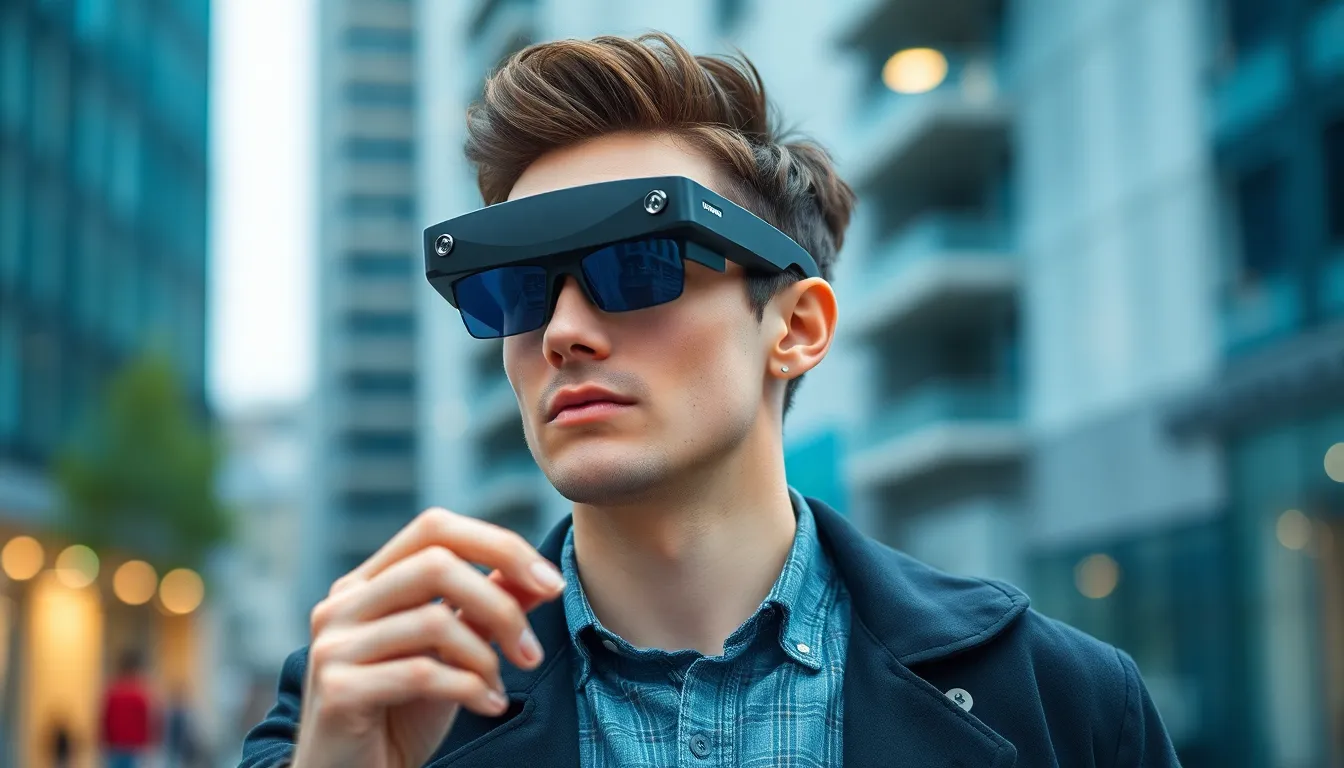Augmented Reality (AR) glasses are transforming the way people interact with the world around them. By seamlessly blending digital information with the physical environment, these innovative devices open up a realm of possibilities for entertainment, education, and productivity. As technology advances, AR glasses are becoming more accessible, captivating a growing audience eager to experience this new frontier.
From enhancing gaming experiences to revolutionizing workplace training, AR glasses offer a unique perspective that traditional screens simply can’t match. With major tech companies investing heavily in this space, the future of AR is bright and full of potential. As users embrace this cutting-edge technology, they’ll discover how AR glasses can enrich their daily lives and redefine their understanding of reality.
Table of Contents
ToggleOverview of AR Glasses
AR glasses overlay digital content onto the physical environment, blending real and virtual elements. These devices feature advanced sensors, cameras, and displays that enable users to see virtual objects as if they exist in their immediate surroundings. The primary functions of AR glasses include displaying information, facilitating interactive experiences, and enhancing user engagement.
Several key features define modern AR glasses:
- Display Technology: Most AR glasses use micro-OLED or LCD displays, providing high-resolution visuals. These displays project images onto lenses, allowing users to view digital content transparently.
- Gesture Recognition: AR glasses utilize cameras and sensors to detect user gestures. This functionality enables intuitive controls, allowing users to interact with digital objects through hand movements.
- Voice Control: Many AR glasses support voice commands for hands-free operation. Users can execute commands, access information, or interact with applications using vocal instructions.
- Connectivity: AR glasses typically connect to smartphones or Wi-Fi networks. This connectivity allows them to access cloud-based services, download applications, and receive updates.
AR glasses serve various applications across multiple sectors:
- Entertainment: In gaming, AR glasses create immersive experiences that enhance participation. Players interact with digital characters and objects integrated into real-world environments.
- Education: Educational institutions employ AR glasses for interactive learning. Students visualize complex concepts, engage with simulations, and experience hands-on training without risk.
- Workplace Training: Industries leverage AR glasses for training programs, providing real-time guidance. Trainees access detailed instructions and diagrams while performing tasks on-site, enhancing skill acquisition.
The market for AR glasses continues to grow, driven by advancements in technology and increased investments from major tech companies. As accessibility improves, AR glasses are set to reshape how individuals perceive and interact with their environments.
Key Features of AR Glasses

AR glasses incorporate various advanced features that enhance user experience and functionality. The following key aspects contribute to their effectiveness and appeal.
Display Technology
High-resolution display technology enhances visual quality in AR glasses, ensuring crisp and clear images. Many models utilize microLED or OLED displays, providing vibrant colors and deep contrasts. Field of view varies among devices, typically ranging from 40 to 120 degrees, influencing immersion. Some glasses feature adaptive brightness and contrast adjustments, optimizing visuals for different lighting conditions.
Battery Life
Battery life remains a critical aspect of AR glasses, directly affecting usability. Most devices offer battery durations from 2 to 8 hours on a single charge, suitable for various applications. Efficient energy management systems often extend usage beyond standard limits, with features like power-saving mode activated during inactivity. Additionally, quick-charging capabilities can reduce downtime, allowing users to recharge within 30 to 60 minutes.
Design and Comfort
Ergonomic design and comfort play essential roles in user satisfaction with AR glasses. Lightweight materials often weigh between 50 to 100 grams, minimizing strain during prolonged use. Adjustable frames accommodate different head sizes and shapes, enhancing fit and comfort. Some models incorporate soft padding or sweat-resistant materials, improving wearability during extended sessions. Stylish designs attract diverse users, marrying technology with fashion seamlessly.
Popular AR Glasses Models
Several AR glasses models are leading the market, each offering unique features and capabilities. The following models exemplify the current advancements in AR technology.
Model A
Model A features a high-resolution OLED display that provides vivid visuals and a wide field of view. Its integrated cameras capture real-time data, enabling immersive experiences for users. Gesture recognition allows for intuitive interactions, while voice command support enhances hands-free usability. The lightweight design, coupled with an adjustable frame, ensures comfort during extended wear. Battery life ranges from 4 to 6 hours, making it suitable for various applications like gaming and training.
Model B
Model B stands out with its microLED display technology, delivering exceptional brightness and clarity. This model includes advanced spatial awareness capabilities, enabling it to track surroundings and overlay digital information seamlessly. Its ergonomic design incorporates breathable materials, enhancing comfort for prolonged use. The device offers connectivity options such as Wi-Fi and Bluetooth, facilitating interaction with smartphones and other devices. Battery performance lasts between 5 to 8 hours, supporting extended usage.
Model C
Model C is designed for professional environments, featuring a robust augmented reality platform tailored for industrial applications. Its high-resolution eye-tracking system allows for precise user interactions with AR content. Equipped with a durable, rugged frame, Model C withstands various work conditions while maintaining a lightweight profile. Users benefit from seamless integration with enterprise applications for enhanced productivity and training. The battery offers up to 6 hours of continuous operation, making it efficient for demanding environments.
Use Cases for AR Glasses
AR glasses offer diverse applications across various fields, enhancing experiences and improving functionality. Below are key use cases that illustrate their potential.
Gaming and Entertainment
AR glasses transform gaming and entertainment by merging virtual content with the real world. Gamers interact with digital characters and elements in their actual surroundings through immersive experiences. Titles like “Pokémon GO” exemplify this trend, allowing players to catch virtual creatures in physical spaces. Furthermore, AR glasses can deliver live events, concerts, and sports with enriched visuals, providing fans with unique real-time interaction. Developers continue to push boundaries, creating engaging storytelling and interactive gameplay.
Education and Training
AR glasses revolutionize education and training by delivering interactive and immersive learning experiences. Students engage with 3D models and digital simulations that enhance comprehension and retention. For instance, medical students can practice surgical procedures using realistic holograms. In corporate environments, AR glasses facilitate hands-on training, allowing employees to visualize complex machinery and protocols, leading to increased efficiency and knowledge retention. Institutions are adopting these technologies to create learning environments that inspire creativity and innovation.
Industrial Applications
AR glasses significantly enhance productivity and safety in industrial applications. Workers gain access to real-time data and instructions overlaid on their field of vision, streamlining complex tasks. For example, maintenance technicians can see step-by-step repair guides while repairing machinery, minimizing errors and downtime. Additionally, AR glasses can assist in remote support, enabling experts to provide guidance through live video feeds and annotations. Industries such as manufacturing, construction, and logistics are integrating AR technology to improve operational efficiencies and reduce risks.



